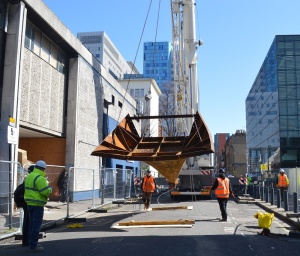Neuron Pod, London
Structural Steel Design Awards 2019 - Commendation
The Neuron Pod is a new addition to Centre of the Cell, an award-winning science education centre at Queen Mary University of London’s Whitechapel campus. To address ever-increasing demand, the Neuron Pod will help increase visitor numbers and provide a multi-functional space for live science shows, hands-on workshops, experiments, debates, films and exhibitions.
Made out of weathering steel, the Pod consists of an external structural skin stiffened by internal steel ribs. These internal ribs run in both directions to provide stiffness and rigidity to the structural skin. Inspired by a Zeppelin shape, both in plan and elevations, it is supported by three legs. The overall shape presents a curved surface, resembling the central part of a neuron, while the dendrites are shaped in the form of numerous spikes scattered along the external surface of the Pod.
Constructed following a process similar to the construction of a ship’s hull, the structure comprises 8mm thick precise laser-cut flat metal sheets, curved in place using the vertical ribs as an embedded structural formwork and then welded.
This project was designed, analysed and produced using a bespoke workflow to generate the surface, implement the structural ribbing and splicing following the overall stress patterns, and then produce a full set of construction drawings. The smooth surface obtained with a computer-generated algorithm was envisaged as a starting point. A subsequent step was to study a subdivision pattern to discretise the overall shape into developable strips. This allowed a quick generation of various options for the ribs, and once the loading criteria were set, it allowed fine-tuning of the pattern to balance the target of limiting the self-weight (and therefore material) with the needs of strength and stiffness.
The workflow output was then used by the steelwork contractor to cut, assemble and weld the pieces. The various pieces were temporarily bolted together on-site in order to minimise the temporary props required. Once the jigsaw was complete, the bolted interfaces were welded to create the final structural continuity, allowing the temporary props to be removed.
With a weathering steel Pod and galvanized steel connecting bridge, the materials used provide a lasting durability to the structure, whilst retaining the aesthetic quality the architect envisioned and providing the ‘wow’ factor the client wanted. Without adding to the structural elements, this piece provides an art installation as well as a functional teaching space increasing the capacity of facilities available in the university.
| Architect | aLL Design |
| Structural Engineer | AKT II |
| Main Contractor | Total Construction |
| Client | Queen Mary University of London |
Judges' comment
The Neuron Pod, the latest addition to Queen Mary University of London Cell Education Centre, surprises in its animal form, is fun and colourful. These qualities meet the brief of inspiring and hopefully attracting future scientists. This contemporary work of craftsmanship in weathering steel succeeds in striking a whimsical note with serious scientific educational intent.





